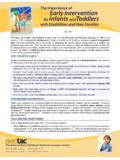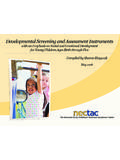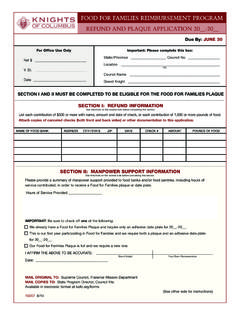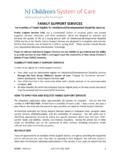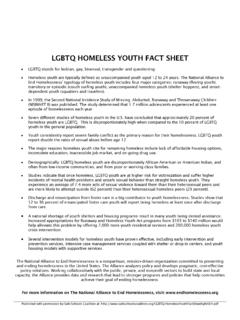Transcription of Principles-Looks Like- Doesnt Look Like 02-27-08
1 03/11/08 SEVEN KEY PRINCIPLES: LOOKS LIKE / DOESN T LOOK LIKE Developed by the Workgroup on Principles and Practices in Natural Environments Workgroup Members: Susan Addision, Betsy Ayankoya, Mary Beth Bruder, Carl Dunst, Larry Edelman, Andy Gomm, Barbara Hanft, Cori Hill, Joicey Hurth, Grace Kelley, Anne Lucas, Robin McWilliam, Stephanie Moss, Lynda Pletcher, Dathan Rush, M Lisa Shelden, Mary Steenberg, Judy Swett, Nora Thompson, Julianne Woods, and Naomi Younggren. Description and Suggested Use: This document elaborates on the 7 key principles identified by work group members, listing the concepts underlying the brief statements.
2 Each principle also has descriptive statements illustrating what the principle should look like in practice. There are also descriptions of what it doesn t look like because too often those practices are still being used. While the work group offered much input, no attempt was made to achieve consensus. The Looks Like / Doesn t Look Like statements are simply examples. Many others could be added. The document may be particularly useful as training material. Lively discussions occur when the principles and concepts are provided and participants draft their own Looks Like / Doesn t Look Like statements.
3 Please use the following citation when referring to this work. Please use the following when citing this work: Workgroup on Principles and Practices in Natural Environments, OSEP TA Community of Practice: Part C Settings. (2008, March). Seven key principles: Looks like / doesn t look like. Retrieved from ~pdfs/topics/ Workgroup on Principles and Practices in Natural Environments OSEP TA Community of Practice- Part C Settings 1 03/11/08 Seven Key Principles: Looks Like/Doesn t Look Like 1. Infants and toddlers learn best through every day experiences and interactions with familiar people in familiar contexts.
4 Key Concepts Learning activities and opportunities must be functional, based on child and family interest and enjoyment Learning is relationship-based Learning should provide opportunities to practice and build upon previously mastered skills Learning occurs through participation in a variety of enjoyable activities This principle DOES look like this This principle DOES NOT look like this Using toys and materials found in the home or community setting Using toys.
5 Materials and other equipment the professional brings to the visit Helping the family understand how their toys and materials can be used or adapted Implying that the professional s toys, materials or equipment are the magic necessary for child progress Identifying activities the child and family like to do which build on their strengths and interests Designing activities for a child that focus on skill deficits or are not functional or enjoyable Observing the child in multiple natural settings, using family input on child s behavior in various routines, using formal and informal developmental measures to understand the child s strengths and developmental functioning Using only standardized measurements to understand the child s strengths.
6 Needs and developmental levels Helping caregivers engage the child in enjoyable learning opportunities that allow for frequent practice and mastery of emerging skills in natural settings Teaching specific skills in a specific order in a specific way through massed trials and repetition in a contrived setting Focusing intervention on caregivers ability to promote the child s participation in naturally occurring, developmentally appropriate activities with peers and family members Conducting sessions or activities that isolate the child from his/her peers, family members or naturally occurring activities Assuming principles of child learning, development, and family functioning apply to all children regardless of disability label Assuming that certain children, such as those with autism.
7 Cannot learn from their families through naturally occurring learning opportunities Workgroup on Principles and Practices in Natural Environments OSEP TA Community of Practice- Part C Settings 2 03/11/08 2. All families , with the necessary supports and resources, can enhance their children s learning and development. Key Concepts All means ALL (income levels, racial and cultural backgrounds, educational levels, skill levels, living with varied levels of stress and resources) The consistent adults in a child s life have the greatest influence on learning and development-not EI providers All families have strengths and capabilities that can be used to help their child All families are resourceful, but all families do not have equal access to resources Supports (informal and formal)
8 Need to build on strengths and reduce stressors so families are able to engage with their children in mutually enjoyable interactions and activities This principle DOES look like this This principle DOES NOT look like this Assuming all families have strengths and competences; appreciating the unique learning preferences of each adult and matching teaching, coaching, and problem solving styles accordingly Basing expectations for families on characteristics, such as race, ethnicity, education, income or categorizing families as those who are likely to work with early intervention and those who won t Suspending judgment, building rapport, gathering information from the family about their needs and interests Making assumptions about family needs, interests.
9 And ability to support their child because of life circumstances Building on family supports and resources; supporting them to marshal both informal and formal supports that match their needs and reducing stressors Assuming certain families need certain kinds of services, based on their life circumstances or their child s disability Identifying with families how all significant people support the child s learning and development in care routines and activities meaningful and preferable to them Expecting all families to have the same care routines, child rearing practices and play preferences.
10 Matching outcomes and intervention strategies to the families priorities, needs and interests, building on routines and activities they want and need to do; collaboratively determining the supports, resources and services they want to receive Viewing families as apathetic or exiting them from services because they miss appointments or don t carry through on prescribed interventions, rather than refocusing interventions on family priorities Matching the kind of help or assistance with what the family desires; building on family strengths, skills and interests to address their needs Taking over and doing everything for the family or, conversely, telling the family what to do and doing nothing to assist them Workgroup on Principles and Practices in Natural Environments OSEP TA Community of Practice- Part C Settings 3 03/11/08 3.



